AMD Zen 3 Ryzen Deep Dive Review: 5950X, 5900X, 5800X and 5600X Tested
by Dr. Ian Cutress on November 5, 2020 9:01 AM ESTCPU Tests: Encoding
One of the interesting elements on modern processors is encoding performance. This covers two main areas: encryption/decryption for secure data transfer, and video transcoding from one video format to another.
In the encrypt/decrypt scenario, how data is transferred and by what mechanism is pertinent to on-the-fly encryption of sensitive data - a process by which more modern devices are leaning to for software security.
Video transcoding as a tool to adjust the quality, file size and resolution of a video file has boomed in recent years, such as providing the optimum video for devices before consumption, or for game streamers who are wanting to upload the output from their video camera in real-time. As we move into live 3D video, this task will only get more strenuous, and it turns out that the performance of certain algorithms is a function of the input/output of the content.
HandBrake 1.32: Link
Video transcoding (both encode and decode) is a hot topic in performance metrics as more and more content is being created. First consideration is the standard in which the video is encoded, which can be lossless or lossy, trade performance for file-size, trade quality for file-size, or all of the above can increase encoding rates to help accelerate decoding rates. Alongside Google's favorite codecs, VP9 and AV1, there are others that are prominent: H264, the older codec, is practically everywhere and is designed to be optimized for 1080p video, and HEVC (or H.265) that is aimed to provide the same quality as H264 but at a lower file-size (or better quality for the same size). HEVC is important as 4K is streamed over the air, meaning less bits need to be transferred for the same quality content. There are other codecs coming to market designed for specific use cases all the time.
Handbrake is a favored tool for transcoding, with the later versions using copious amounts of newer APIs to take advantage of co-processors, like GPUs. It is available on Windows via an interface or can be accessed through the command-line, with the latter making our testing easier, with a redirection operator for the console output.
We take the compiled version of this 16-minute YouTube video about Russian CPUs at 1080p30 h264 and convert into three different files: (1) 480p30 ‘Discord’, (2) 720p30 ‘YouTube’, and (3) 4K60 HEVC.
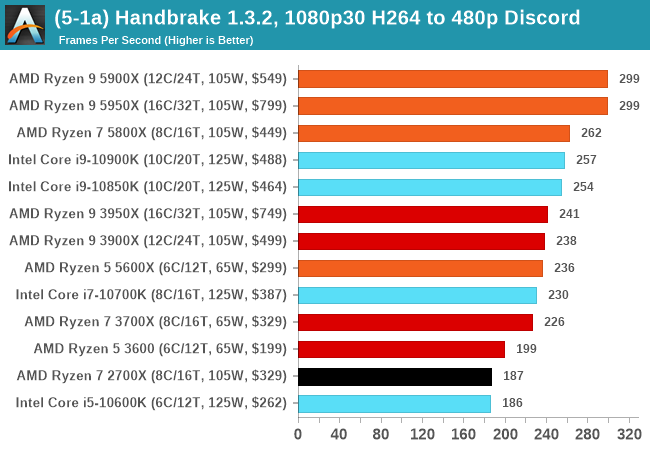
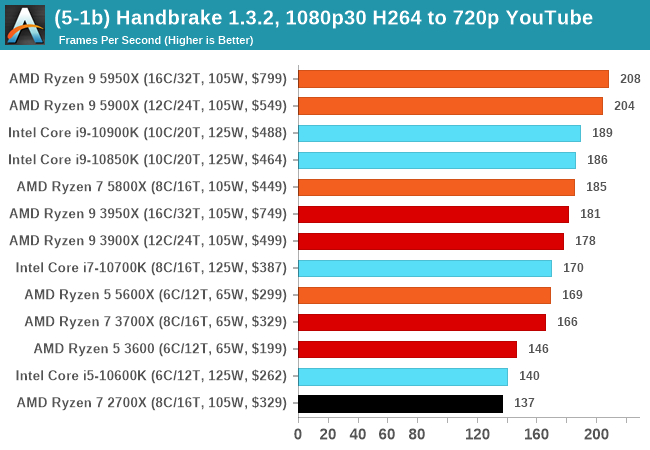
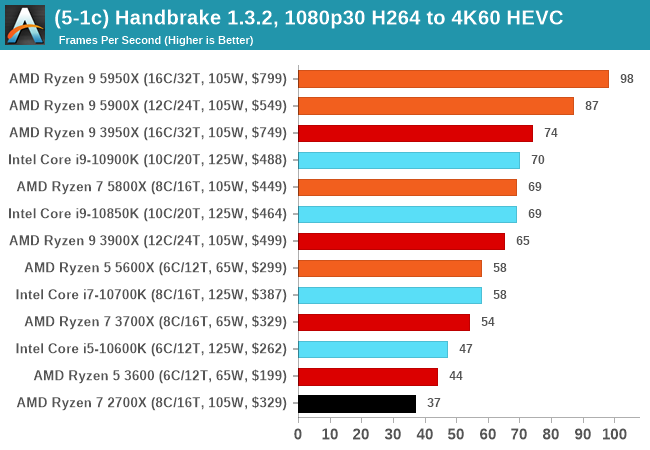
7-Zip 1900: Link
The first compression benchmark tool we use is the open-source 7-zip, which typically offers good scaling across multiple cores. 7-zip is the compression tool most cited by readers as one they would rather see benchmarks on, and the program includes a built-in benchmark tool for both compression and decompression.
The tool can either be run from inside the software or through the command line. We take the latter route as it is easier to automate, obtain results, and put through our process. The command line flags available offer an option for repeated runs, and the output provides the average automatically through the console. We direct this output into a text file and regex the required values for compression, decompression, and a combined score.

AES Encoding
Algorithms using AES coding have spread far and wide as a ubiquitous tool for encryption. Again, this is another CPU limited test, and modern CPUs have special AES pathways to accelerate their performance. We often see scaling in both frequency and cores with this benchmark. We use the latest version of TrueCrypt and run its benchmark mode over 1GB of in-DRAM data. Results shown are the GB/s average of encryption and decryption.
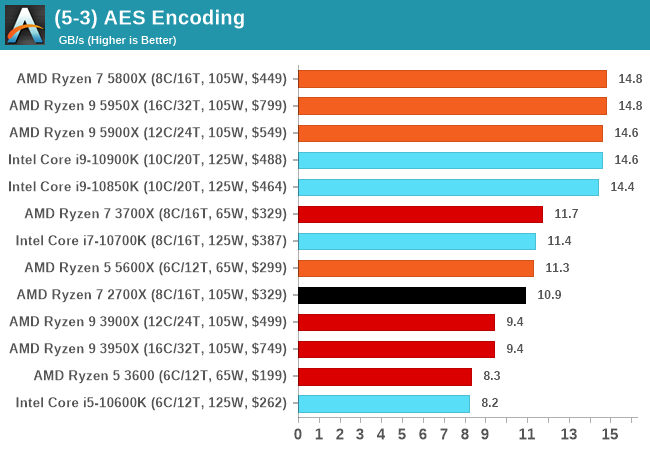
WinRAR 5.90: Link
For the 2020 test suite, we move to the latest version of WinRAR in our compression test. WinRAR in some quarters is more user friendly that 7-Zip, hence its inclusion. Rather than use a benchmark mode as we did with 7-Zip, here we take a set of files representative of a generic stack
- 33 video files , each 30 seconds, in 1.37 GB,
- 2834 smaller website files in 370 folders in 150 MB,
- 100 Beat Saber music tracks and input files, for 451 MB
This is a mixture of compressible and incompressible formats. The results shown are the time taken to encode the file. Due to DRAM caching, we run the test for 20 minutes times and take the average of the last five runs when the benchmark is in a steady state.
For automation, we use AHK’s internal timing tools from initiating the workload until the window closes signifying the end. This means the results are contained within AHK, with an average of the last 5 results being easy enough to calculate.
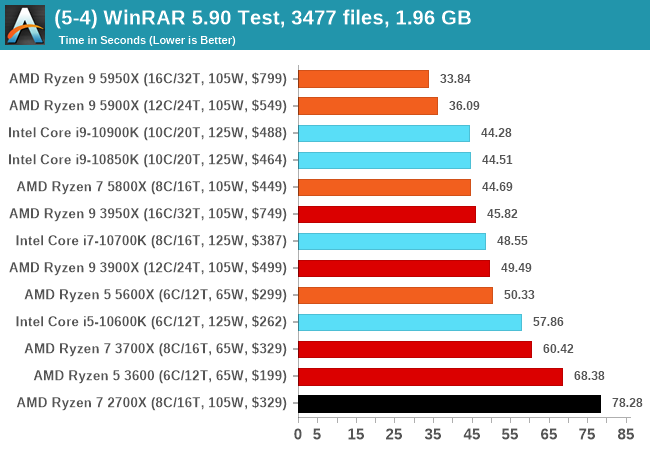


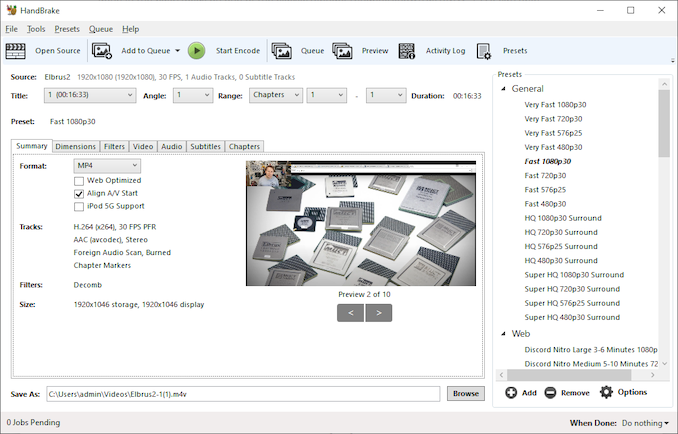
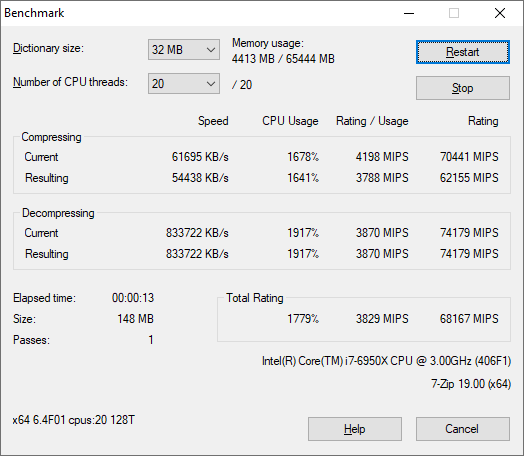
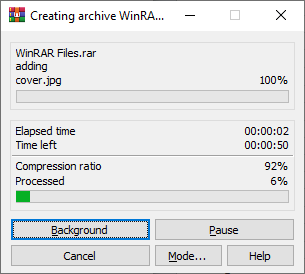








339 Comments
View All Comments
forextor - Friday, November 6, 2020 - link
This article is waay too long..., can be summarised to just one sentence... "Ryzen 5950x... BUY BUY BUYY!!!!"deepblue08 - Friday, November 6, 2020 - link
Wow, I haven't seen this big of a performance jump in a long time! Big Props to AMD!Atom2 - Friday, November 6, 2020 - link
Again and again, for anything that has to do with science and engineering and is not using Intel Compilers and Libraries, the results are for University folks only.wolfesteinabhi - Friday, November 6, 2020 - link
"As we scale up this improvement to the 64 cores of the current generation EPYC Rome, any compute-limited workload on Rome should be freed in Naples."i think you meant "Milan" and not "Naples" in above line.
Body.enhancment.tech.is.subpar - Friday, November 6, 2020 - link
I saw some comments in regards to amd processers, and ppl struggling with installing Windows, or when they might have errors and it being more challenging to deal with compared to Intel.Also I noticd that amd has no on board graphics on their chip.
So my question, is someone could please clarify;
Is Amd, or rather zen 2, if anything to go by, is difficult to set up. Also if there are difference in compatiblity compared to intel in terms of software (including OS'es) in general and cpu work.
Also since there is no on board gpu for AMD does that mean when reinstalling GPU drivers for a main GPU unit, that there is a complicated and different way to install?
As you can tell, I have 0 experience with AMD, and been happy with Intel and the stability that they have.
So can anyone if they would be so inclined, may be tell me there is no reason to fret, and become an AMD fan boy?
Since their new CPUs are looking quite nice, but I am hesitant since I am not willing to deal with a head ache for performance gains when it does work. I would give up a bit of performance for peace of mind.
supdawgwtfd - Friday, November 6, 2020 - link
Uhhh....Windows just installs and works.
No issues.
You just need a GPU or any type.
Qasar - Friday, November 6, 2020 - link
if you have done this with intel, its the same processCookieBin - Friday, November 6, 2020 - link
My Threadripper crashed if you opened anything on startup. It didn't like loading games either, would cause a blue screen. After several reinstalls, it sometimes works. My opinion is AMD sucks at drivers, and that's not hard to believe, because radeon cards had the same issues. With AMD, YOU are the beta user :)dagobah123 - Friday, November 6, 2020 - link
I've had 2 threadrippers and don't have these issues. Which gpu and drivers are you on? What is your current build of Windows? Is your memory compatible? Are your BIOS drivers up to date?Spunjji - Sunday, November 8, 2020 - link
Smells like FUD